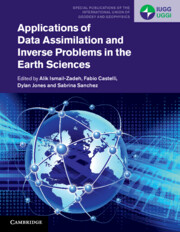Book contents
- Applications of Data Assimilation and Inverse Problems in the Earth Sciences
- Series page
- Applications of Data Assimilation and Inverse Problems in the Earth Sciences
- Copyright page
- Contents
- Contributors
- Preface
- Acknowledgements
- Part I Introduction
- 1 Inverse Problems and Data Assimilation in Earth Sciences
- 2 Emerging Directions in Geophysical Inversion
- 3 A Tutorial on Bayesian Data Assimilation
- 4 Third-Order Sensitivity Analysis, Uncertainty Quantification, Data Assimilation, Forward and Inverse Predictive Modelling for Large-Scale Systems
- Part II ‘Fluid’ Earth Applications: From the Surface to the Space
- Part III ‘Solid’ Earth Applications: From the Surface to the Core
- Index
- References
2 - Emerging Directions in Geophysical Inversion
from Part I - Introduction
Published online by Cambridge University Press: 20 June 2023
- Applications of Data Assimilation and Inverse Problems in the Earth Sciences
- Series page
- Applications of Data Assimilation and Inverse Problems in the Earth Sciences
- Copyright page
- Contents
- Contributors
- Preface
- Acknowledgements
- Part I Introduction
- 1 Inverse Problems and Data Assimilation in Earth Sciences
- 2 Emerging Directions in Geophysical Inversion
- 3 A Tutorial on Bayesian Data Assimilation
- 4 Third-Order Sensitivity Analysis, Uncertainty Quantification, Data Assimilation, Forward and Inverse Predictive Modelling for Large-Scale Systems
- Part II ‘Fluid’ Earth Applications: From the Surface to the Space
- Part III ‘Solid’ Earth Applications: From the Surface to the Core
- Index
- References
Summary
Abstract: In this chapter, we survey some recent developments in the field of geophysical inversion. We aim to provide an accessible general introduction to the breadth of current research, rather than focusing in depth on particular topics. We hope to give the reader an appreciation for the similarities and connections between different approaches, and their relative strengths and weaknesses.
Keywords
- Type
- Chapter
- Information
- Publisher: Cambridge University PressPrint publication year: 2023
References
- 1
- Cited by



